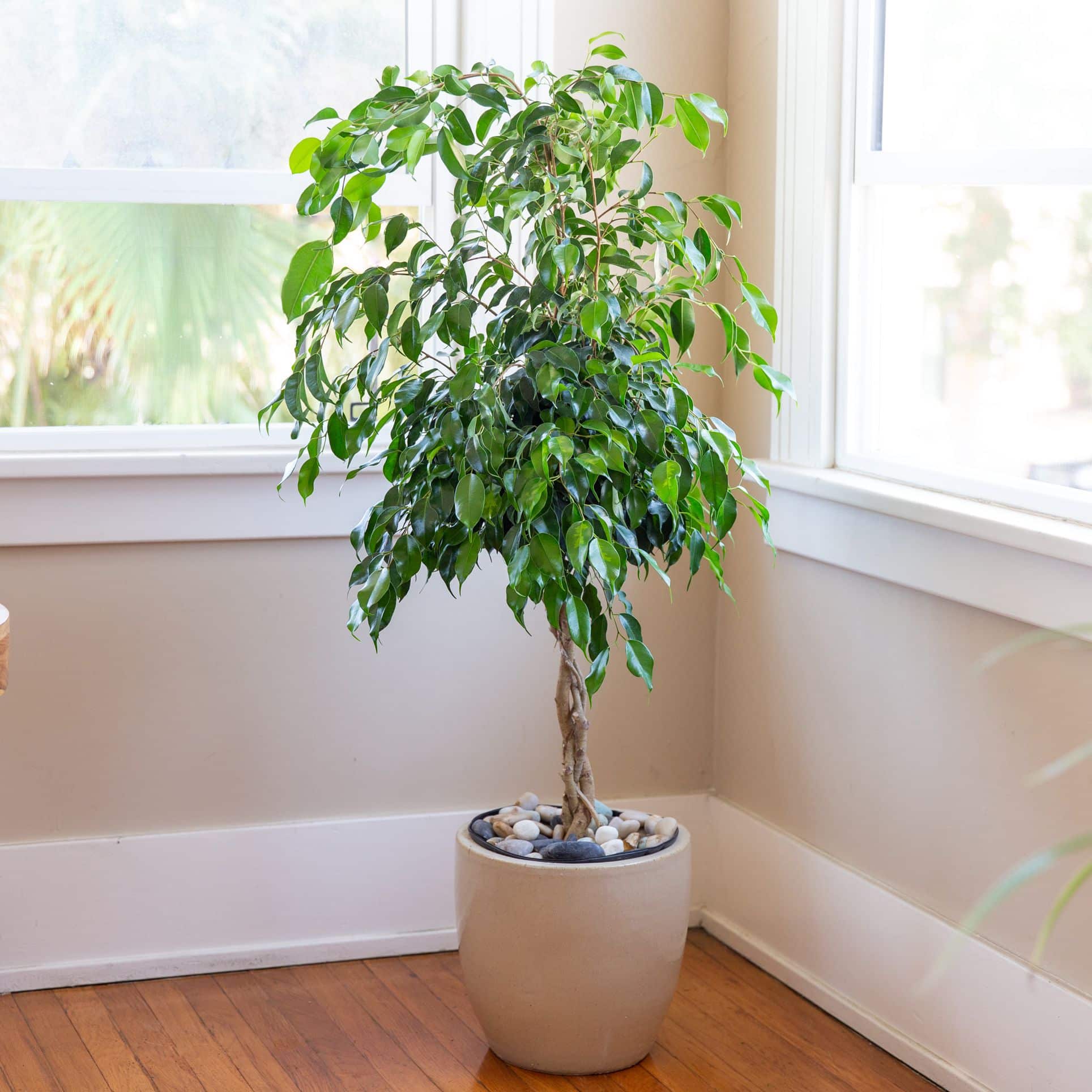Ficus houseplant grows as big broadleaf. It is an evergreen plant that grows excellently in tropical and subtropical climatic conditions.
The origin of ficus houseplant is India, South Asia, and the Northside of Australia. Due to its unique and innovative feature of commercial landscaping, it is usually planted inside homes and offices.
The Ficus houseplant is adorable, tolerant of low light, and can survive the limited light of the indoor environment as well.
The plant branches and dark and glossy leaves curved beautifully from the light grey trunk. If the plant goes through difficult conditions, its leaves may be shed.
While planting indoors, these plants are usually kept 3 to 6 feet tall. The beautiful and eye-catching trunks are used for decorative and ornamental purposes.
How adorable it is, to experience the silence of growing things!
One interesting fact about the Ficus houseplant is that it improves the airflow inside houses. Now, the question arises: How does the Ficus houseplant improve the air quality?
The answer is that its Ficus captures air toxins such as benzene, formaldehyde, or trichloroethylene.
Furthermore, it is a fast-growing plant and requires repotting once a year.
Basic Elements of Ficus Houseplant
If you want to grow a ficus houseplant, you should know all its fundamentals so that it can grow without any hardship.
The botanical name of ficus is Ficus benjamina. It is commonly known as the Weeping fig, ficus tree, or Benjamin fig.
This is an evergreen type of plant, and the most suitable place for it to grow perfectly is inside the house.
Learn the character from trees, the importance and values from the roots, and change from the leaves (color)!
It requires good, well-drained potting soil with an acidic to neutral ph for fast growth. It can grow up to 60 feet when planted outside. These plants can grow up to 3 to 6 feet in an indoor environment.
Regarding sunlight, the ficus houseplant can survive bright and filtered sunlight. They don’t give flowers. They are non-poisonous plants.
Care & Ailment of Ficus Houseplant
Ficus is a very convenient plant to grow indoors. They can grow beautifully in containers filled with rich and damped soil.
The only thing the ficus houseplant requires to grow properly is good container positioning, which allows it to capture plenty of bright light. During its season of growth, it requires proper watering.
Nevertheless, they can also maintain themselves in dry potting soil in winter. In the flowering season, it is best to take your ficus houseplant outdoors and allow it to blossom.
After the season ends, you can take them back to their place. Sometimes, the plant shows infestation by the most popular houseplant pests, aphids, mealybugs, and whiteflies. It is important to protect your ficus from these pests.
Tips and Tricks for Growing Ficus Houseplant

Ficus is a very friendly plant that doesn’t require too much attention. However, some key points must be considered.
Day-light
For proper and speedy growth, ficus houseplants need to be placed in the brightest room of the house, where they can consume indirect and filtered sunlight in abundance. Moreover, in winter, they can survive direct sunlight, too.
It can also grow in partially shaded light conditions. If you repeatedly change the place where the plant grows, it may drop its leaves. So, try finding the perfect place for your plant.
Rich Soil
Any good, fast-draining potting soil will work best for your ficus houseplant. The ficus doesn’t need soil that is highly rich in nutritional values.
Your ficus shows noticeable progress if perlite, sand, and vermiculite are found in the soil for enhanced drainage.
Balanced Water
Plenty of watering makes your plant drop its leaves or damage the growth of roots. If your plant drops some of the leaves at the start of winter, then there is nothing to worry about as these plants are quite sensitive to changes in atmospheric conditions as
One falling leaf is not just a leaf – it indicates the whole autumn!
Temperature and Moisture Control
Dark times are the best times for the ficus houseplant to grow. The temperature between 65 to 70 degrees Fahrenheit at night and 75 to 85 degrees during the day will work best for Ficus.
Here, the precaution is not to use extremely heavy air conditioners in the summer because the ficus plant will be affected if the temperature goes below 70 degrees Fahrenheit.
While talking about humidity, it was previously discussed that the ficus plant belongs to a tropical atmosphere, so it appreciates high humidity. If the humidity is low, the ficus begins to lose its leaves.
To prevent humidity, the soil must be kept damp and moist frequently to prevent the plant from drying out.
What About the Toxicity of Ficus Houseplant?
Generally, Ficus is not toxic, but it is dangerous for those who have latex allergies. This is because latex is the substance found in ficus houseplants.
The plant could not be placed in a similar environment as it shows adverse effects in individuals suffering from latex allergy.
Different Varieties of Ficus
The houseplant presents a wide variety of ficus for its buyers. As it is an extremely beautiful plant. It is widely used for decorative purposes and to bring greenery to houses.
Some of the popular ficus houseplants are listed below:
F. benjamina
Along with the narrow glossy green leaves, it grows into a little shrub. This plant can’t survive in a cool environment for a long time.
F. elastica
This ficus rubber tree contains thick, glossy leaves in abundance. The variety of F. elastica includes F. elastica Robusta, containing large leaves with a wide surface area, and F. elastica decora for decorative and ornamental purposes.
F. lyrata
With the appealing and eye-catching violin-shaped look of leaves of about 18 inches, this ficus houseplant grabs the attention of a variety of customers.
Bottom line
Ficus houseplants are very flexible. They can grow as standards, i.e., in tropical environments, as houseplants, or even as bonsai.
Moreover, they are very easy to propagate. They can also be planted by cuttings, but they cannot be grown with seeds.
You have to take some of the plant cuttings along with the leaves and put them in a container full of moist and drained soil.
Trimming is very important for the proper and speedy growth of the ficus houseplant. Cleaning dead roots and leaves is essential to avoid the spread of fungal diseases. Trimming can be done anytime.
If you love gardening and are fond of planting plants like ficus in your home, consider this article a must-read. If you find this article helpful, give it a thumbs up, and don’t forget to share it with your friends and family.
Happy Planting!








